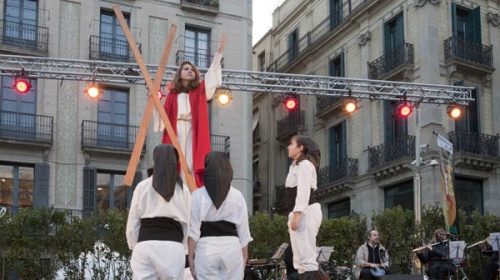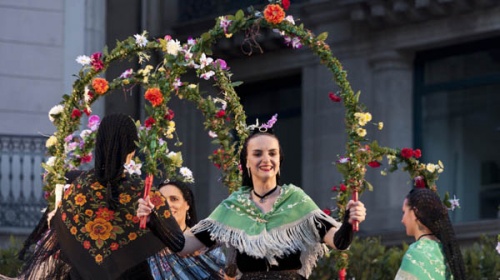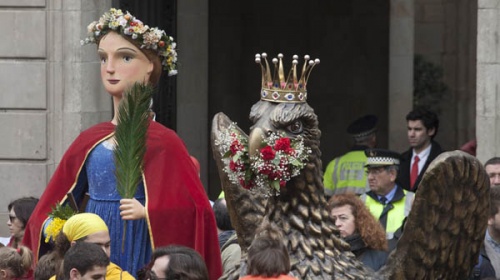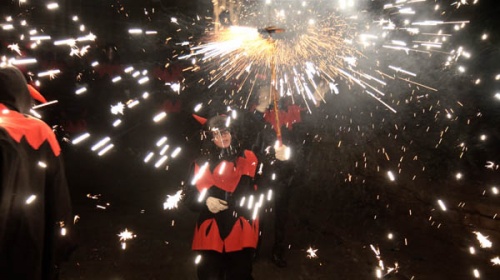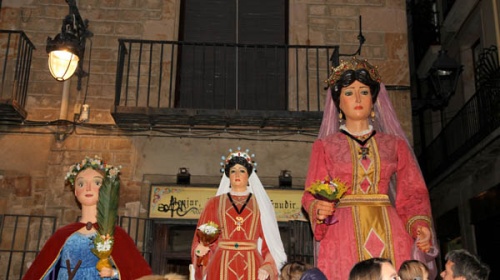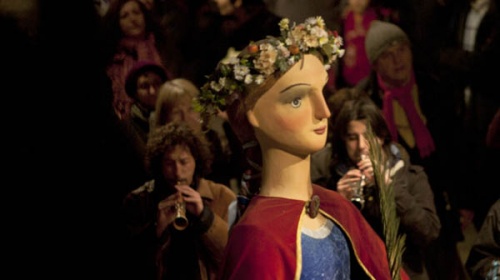Festes de Santa Eulàlia
Activity dates
Dates de celebració
Around the Santa Eulàlia festivities
Feast day: 12 February
Description
The Santa Eulàlia festivities, also known as La Laia or as Barcelona's winter festival, is held around the 12th February each year in squares and streets all across the city.
It is a small and intimate party, full of diverse popular culture activities for all ages. Among the events, highlights include the procession of Laies, the Santa Eulalia parade, human towers in the diada castellera, sardana dancing, and a fire run involving fire beasts and devils both large and small.
Reason
The festival pays homage to St Eulàlia, patron saint of the city since the end of the 17th century. Barcelona legend tells of how, in the 4th century, the Roman Emperor Diocles ordered the persecution of all Christians in the empire. In Barcelona, many hid and some fled. Upon seeing this situation, Eulàlia, a 13-year-old girl who lived in a house in Sarrià, courageously presented herself to the Roman consul Dacià, to protest against such injustice. Eulàlia was imprisoned and punished, but she was not defeated and did not stop fighting for her ideals. This ended up costing her her life.
From then on the girl became a symbol of solidarity and the defence of justice, and she is still venerated by the people of Barcelona.
Origins
The Santa Eulàlia festival celebrations in Barcelona are relatively recent. Not including some folk performances, dances and games that date back to the 18th century, the Santa Eulàlia festivities have been irregular and, well into the 1980s, they were mainly confined to religious activities in the Catholic church and certain institutional celebrations at Barcelona City Hall.
In 1983, as an initiative of the colles de gegants from Ciutat Vella (from Pi and Plaça Nova), and in 1985, with Maria Aurèlia Capmany as Councillor for Culture, the foundations for the new celebration were laid. It took form thanks also to impetus from the Coordinadora de Colles de Gegants i Bestiari in Ciutat Vella, who quickly incorporated several events with traditional roots. Over the years many diverse activities and exhibitions of folk culture have been added that have become repeat events. And finally, in the 1990s, the festes de Santa Eulàlia established a very specific festival protocol which consolidated them further.
Did you know...
Sabies que...
The giantess Laia is a festival figure that symbolises the celebration of Santa Eulàlia. It is the result of the success of a drawing by Carme Solé for the programme and poster of the 1997 Santa Eulalia festival. The petita Laia is a creation of the image-maker Xavier Jansana, who followed the instructions of the artist when constructing the new figure. She made her first public appearance on 12th February, 1998, in the procession of Laies, and since then, she has been carried around by the youngest members of the Ciutat Vella's colles geganteres, who also make her dance.
The giantess Laia takes part in the hanging of the penó flag, in the opening proclamation, the processó de les Laies and in the seguici de Santa Eulàlia procession, where she performs her own dance accompanied by a children's cobla of flabiol flutes and violins.
About festivities
Supplementary information
Organisers
Barcelona City Council.
Other websites
Materials
Protocol festiu de la ciutat de Barcelona. Barcelona City Council. Institute of Culture.




